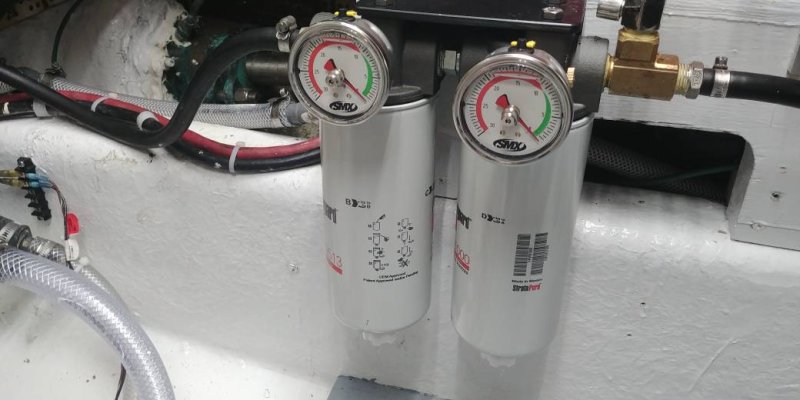Greg QS
Senior Member
- Joined
- Sep 1, 2022
- Messages
- 329
- Vessel Name
- Quiet Storm
- Vessel Make
- Nordlund 61
look up fuel filtration the seaboard way. Sbmar.com
If I did tee off to a return line. I will need a valve so the return fuel goes not go back to the engine or genset? Yes?
I made my own with a sheet of plywood to fit inside a 5-gallon bucket, a Holley diesel fuel pump from Autozone, a leftover small Racor filter I had laying around, and some clear PVC tubing. I mounted everything to the plywood and the bucket is to catch any spills. You don't need a high-flow filter. It is cheap insurance and although it will not get the crud on the bottom or the walls of the fuel tank unless it is agitated, it can be handy to have.
From Sbmar article above
Our preference for a proven Primary or Bulk Separator fuel filter?? In 95% of our work, the Fleetguard “spin-on” FF5013 is the ticket as it offers a 20 mic BETA rating, a flow rate of 100 GPH clean ½” Hg pressure drop, has a built-in water drain, has no “plastic” bowls to leak or discolor, and has proven itself to do the job.
For super high capacity, we use the Fleetguard FS 1218 – About a 250 GPH flow rate, has a “crud capacity” of about 7 times that of a Racor 1000, and has all the best needed features for use as a high capacity Primary bulk separator.
Maybe add this before the racor
It's just a $20 filter
With all do respect to Sbmar, I want my polisher filter separator to have a transparent bowl. If you have water in the tank, I want to be able to see it to drain it. If water is the only contaminant, why keep changing the filter instead of just draining the bowl?
Ted
Is it needed when I have a racor primary and a fine filter on the engine?
Or how would I know the tanks needed it.
The DIY I see online are are simply a Racor and pump recirc fuel?
That's my approach - polish or transfer with 30 mic, transfer to the day tank at 10 mic, then through 2 micron before the fuel hits the OEM filter.Kinda agree, thinking about adding a primary spin off like a FF5013 or a FS2018 then use a 10 mic in the racor which with be the second filter to the engine a 2 micron.
That way having a sequential step (3) down in particle size.
That's my approach - polish or transfer with 30 mic, transfer to the day tank at 10 mic, then through 2 micron before the fuel hits the OEM filter.
I'm using a 1/3 HP ac motor spinning a carbonator pump to get my flow through the same filter body. Especially useful when a tank gets low and we're sloshing around in rough water. The agitation stirs up any gunk, so that's usually when I do most of my polishing.I do the same thing for the same reasons as you. 2600 gallons of diesel, burn like 5-6 gph at cruise, can transfer 3 GPM around through a racor 1000.
I'm using a 1/3 HP ac motor spinning a carbonator pump to get my flow through the same filter body. Especially useful when a tank gets low and we're sloshing around in rough water. The agitation stirs up any gunk, so that's usually when I do most of my polishing.
I found the DC motors didn't last running for eight hours during polishing. If you do get to a replacement decision, check out carbonator pumps spun with an ac motor. They last longer than you will.We have a 12vdc motor driving an oberdorfer pump. I really like the system. With everything working we never run directly from any tank but the day tank (though we could). This means any fuel that gets to the day tank has been ran through the transfer filter. So everything in the tank has at-least gone through a 30micron and water separation.
I use gulf coast F1
My Gulf Coast unit used toilet paper rolls. They recommended using ScottA lot of the gulf coast F1 filters just use rolls of paper towels for their filter. Even some of the "filters" you buy for them are just paper towel rolls wrapped in a mesh.
People I know have reported issues with cellulose particles shedding off these filters and have seen expensive issues caused by these. Usually caught in downstream filters but apparently people have seen issues.
.
I replaced mine because of these concerns.
I believe your boat has 600 hp and 372 gallons of diesel, so odds are fuel polishing is kind of pointless for you. For blue water boats with major tankage going long distances off shore, or refueling in suspect third world locations, it's a must have.
Delfin has 2400 gallons of fuel in seven tanks, and we only burn around 3 gph, so we have a system that moves 180 gph. Can't imagine not having one.
Here you go. Some models of Fleetguard filters do have drains. The FS1000 is10 microns, the FS 19513 is 20 microns. So, yes, one can drain a metal spin-on filter to check for water, quite easily and quite quickly.OC
the 5513 and the 1218 have water drains?

